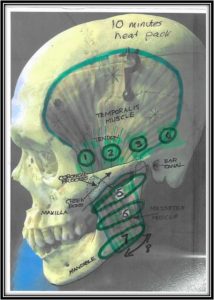Myofunctional Exercises for Myofascial and TMJ Pain

Many headaches and orofacial and/or neck and shoulder pains are caused by over-activity of muscle groups. At Future Dental, we have a range of exercises that we recommend to help ease headaches and pains created by muscular overactivity.
The importance of these exercises
You might ask: Why are we asking you to do these exercises and massage techniques?
You will learn how to self-manage and improve your symptoms from this:
- Use a heat pack for 10 minutes along each side of the face from the temple to the bottom of the jaws and over the ears. A Buck-Wheat Pack is ideal and can be warmed in the microwave for 1.5 – 2.0 minutes. Not hot enough to burn but more than body temperature. If you don’t have a microwave, you could use a hot wet towel or hand towel)
- The fingers are not moved over the skin, like in an oil massage, but grip the skin and roll the skin over the underlying muscle.
- Massage is always across the line of the muscle fibres.
- In the temple area, use all 4 finger-tips together over 1 & 2 and 3 & 4 separately, to massage areas as marked on the diagram in a circular motion about the size of a $2 coin as in positions 1, 2, 3 and 4 on the diagram below.
- In the lower jaw, massage with 2 or 3 fingers horizontally along the 3 lines in the diagram as in lines 5 ,6 and 7 on the diagram.
- The Medial Pterygoid Muscle can only be accessed at home by massaging just inside the line of the lower jaw as in #8 in the diagram. This spot runs from the angle of the jaw to about 3 fingers width in front of that on the lower border of the jaw. It may be easier running one finger parallel to the jaw.
- These two combined sets of exercises should only take about 5-6 minutes in total PLUS the 10-minute warm up time.
Tongue Exercises
The tongue is frequently involved in temporomandibular joint disorders and orofacial pain conditions, and should not be overlooked in management. Lack of strength and tone in the tongue contributes to many jaw pain and airway problems. Incorrect tongue posture and positioning and incorrect swallowing techniques that linger from infancy can be addressed.
The first 3 of these simple exercises should become a habit. The remaining tongue exercises may help if you choose to do these as well:
- A very useful exercise for relaxing the most painful masticatory muscles, the Lateral Pterygoid and Medial Pterygoid Muscle, is to raise the tip of the tongue to the roof of the mouth and hold the tongue on the palate and scrape the tip of the tongue back to the back of the palate.
Repeat this particular exercise 20 times at least twice a day and at any other time you think of it, for example when you are in the shower, while driving etc..
- Open the mouth widely and close again immediately. Repeat 20 times at least twice a day.
- For actual TMJ pain cases, an additional exercise that can be done is to place the tip of the tongue on the palate just behind the upper front teeth, hold it firmly against that spot and open the jaw as wide as you comfortably can and hold it about 5 seconds with the tongue still on the palate. Close again and simply repeat this exercise 3 or 4 times only. And repeat 2-3 times a day along with the above set of exercises.
- “Tik Toks”. This exercise involves sucking the tip of the tongue to the palate behind the upper front teeth and “clicking” it off the palate with the lips first in a smiling position, the “TIK”, and then with the lips pursed as in saying “Oooh” as the “TOK” position. Repeat 20 times 2-3 times daily.
- Close the lips and push the tongue firmly into the upper and lower lips and cheeks, moving the tongue from upper lip, to lower lip and both cheeks. This needs only to take 15-20 seconds each time. Repeat it 3 times each exercise session and 2-3 times daily.
- Drink sips of water through a straw with the teeth held together.
Mindfulness Training
Many headaches and facial/neck pains result from over activity of our autonomic nervous system, our Fight or Flight mechanism which has become overactive when our body does not actually need it. These simple mindfulness tips can be turned into habits that can reduce your stress, anxiety and orofacial problems such as headaches and neck pain.
It takes a month or so to create a habit. One you should consider to help assist with TMJ disorders is to begin using the below exercises consider using your phone to give a recurring alarm noise to make a sound or vibration every 30 minutes for an appropriate period of time to remind yourself to be mindful and to focus on these points:
- Check your posture. Are your shoulders slumped forward and is your back slouching forward? Pull the shoulders back and straighten up your back.
- Is your head posturing forward? Place your fingers on your chin and lightly push backwards to push your head back over your spinal cord.
- Check if your teeth are in contact. If not slightly open the teeth so the teeth are not touching each other.
- Close your lips lightly.
- Place your tongue so it is lightly touching your palate.
- Are you breathing through your nose or mouth? Breathe through your nose.
- Slow your rate of breathing.
- Take shallow breaths not deep breaths.
- Check whether your breathing is through your chest or your tummy. Your chest should not be rising as you breathe in, only your tummy. (Diaphragmatic breathing.)
A few little things that can make a big difference.
A very useful relaxation technique which you enjoy, and can be used in many chronic pain conditions:
- Lie flat on the floor on your back on a gym or yoga mat, not a bed. If the neck is chronically inflexible, use a folded towel so the head is passively held neither head forward nor head backward. The eyes should face straight up.

- Tuck the chin in.
- Place the tip of the tongue on the palate just behind the upper front teeth and close the lips.
- Place one hand on the stomach and the other on the chest.
- Concentrate on regular breathing into the belly not the chest.
- Hold this position for 10 minutes, although longer is fine.
- Repeat this relaxation pose twice a day for at least 2-3 weeks, although it can remain a permanent habit.

How Future Dental can assist myofascial pain
At Future Dental in Cairns, we have over 45 years of experience in treating TMJ pain and myofascial pain. Our team of orofacial pain experts are able to assist with any chronic orofacial pain you may face, and provide appropriate pain management. Contact us today on (07) 4051 4580 or click here to make an appointment.


